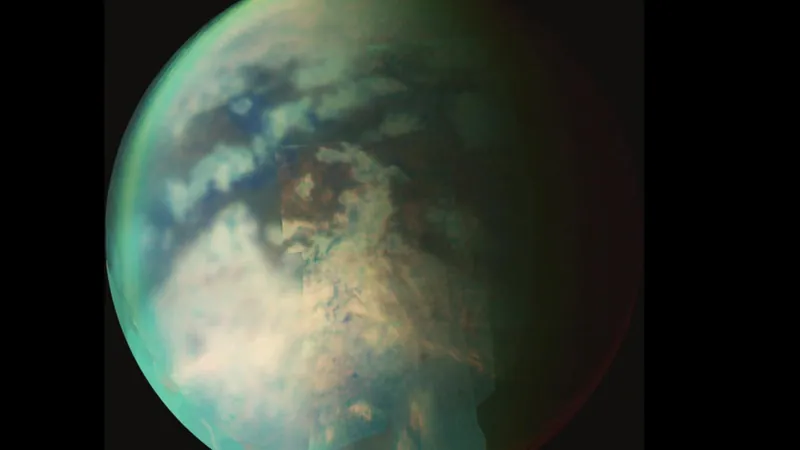
Titan's Mystifying Atmosphere: A Strange New Wobble Uncovered
2025-06-10
Author: Ken Lee
Titan's Atmospheric Enigma Deepens
For years, scientists have been captivated by a puzzling "wobble" in Titan, Saturn's intriguing largest moon. Recent research has uncovered mind-boggling clues about this enigmatic tilt, while simultaneously opening the door to even more perplexing questions.
Thanks to data collected from the Cassini mission, we've learned that Titan’s atmosphere has a unique behavior: unlike Earth's, it doesn’t rotate in sync with the moon's surface. Instead, it's akin to a spinning top, tilting and shifting in a captivating seasonal dance.
What Caused the Wobble?
Lead researcher Lucy Wright from the University of Bristol expressed her astonishment, stating, "The behavior of Titan's atmospheric tilt is very strange. We think some historical event may have knocked the atmosphere off its spin axis, sparking this wobble."
Scientists initially theorized that either Saturn's immense gravitational pull or the sun's position influenced this tilt. Typically, in planetary systems, these forces dictate atmospheric behavior, leading to shifts over time. Yet, Titan's tilt remains consistently oriented in space, seemingly unresponsive to such external influences.
An Unexpected Discovery
This unexpected finding suggests that other unknown processes might govern Titan’s atmospheric dynamics, as detailed in a recently published study in The Planetary Science Journal. Co-author Nick Teanby commented, "We expected to uncover clues regarding the cause, but instead, we’re facing a compelling new mystery."
Titan: A World of Its Own
Fascinatingly, Titan is the only moon in our solar system sporting a substantial atmosphere, rich in nitrogen and complex organic molecules. This combination makes Titan a hotbed for studying atmospheric processes and potential prebiotic chemistry.
Between 2004 and 2017, NASA’s Cassini spacecraft provided incredible insights into Titan’s atmosphere, observing significant changes, including a constant tilt in mid-layers and seasonal swirling winter polar vortices.
What's Next for Titan?
Understanding this aerodynamic wobble is crucial for NASA's upcoming Dragonfly mission, which aims to reach Titan in the 2030s. Given that Titan's winds greatly exceed its surface rotation speed, grasping how the atmosphere fluctuates seasonally will be vital for planning a safe landing.
Conor Nixon, a planetary scientist at NASA’s Goddard Space Flight Center, noted, "Our findings show there are still astonishing discoveries to be uncovered in Cassini's archive. This remarkable instrument, partly developed in the U.K., traversed the Solar System, continually delivering invaluable scientific insights."
Implications Beyond Titan
Nixon further highlighted, "The fact that Titan’s atmosphere behaves like a spinning top, disconnected from its surface, raises intriguing questions—not only for Titan itself but also for broader atmospheric physics, including that of our own Earth."



 Brasil (PT)
Brasil (PT)
 Canada (EN)
Canada (EN)
 Chile (ES)
Chile (ES)
 Česko (CS)
Česko (CS)
 대한민국 (KO)
대한민국 (KO)
 España (ES)
España (ES)
 France (FR)
France (FR)
 Hong Kong (EN)
Hong Kong (EN)
 Italia (IT)
Italia (IT)
 日本 (JA)
日本 (JA)
 Magyarország (HU)
Magyarország (HU)
 Norge (NO)
Norge (NO)
 Polska (PL)
Polska (PL)
 Schweiz (DE)
Schweiz (DE)
 Singapore (EN)
Singapore (EN)
 Sverige (SV)
Sverige (SV)
 Suomi (FI)
Suomi (FI)
 Türkiye (TR)
Türkiye (TR)
 الإمارات العربية المتحدة (AR)
الإمارات العربية المتحدة (AR)